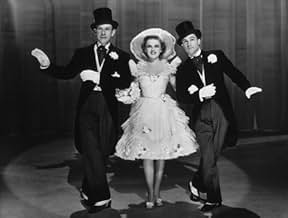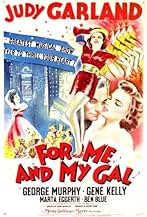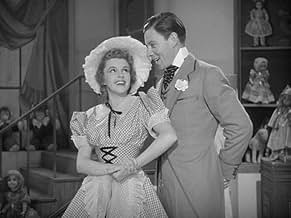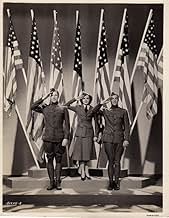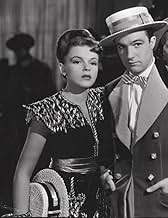PUNTUACIÓN EN IMDb
7,0/10
4,1 mil
TU PUNTUACIÓN
Añade un argumento en tu idiomaTwo vaudeville performers fall in love, but find their relationship tested by the arrival of WWI.Two vaudeville performers fall in love, but find their relationship tested by the arrival of WWI.Two vaudeville performers fall in love, but find their relationship tested by the arrival of WWI.
- Dirección
- Guión
- Reparto principal
- Nominado para 1 premio Óscar
- 4 premios y 1 nominación en total
Mártha Eggerth
- Eve Minard
- (as Marta Eggerth)
Stephen McNally
- Mr. Waring
- (as Horace McNally)
Ernie Alexander
- Theater Workman with Big Die
- (sin acreditar)
Hooper Atchley
- Assistant Stage Manager
- (sin acreditar)
Walter Baldwin
- Bill
- (sin acreditar)
Gurney Bell
- Member - Sportsmen Quartet
- (sin acreditar)
Herman Boden
- Soldier
- (sin acreditar)
John Breen
- Soldier
- (sin acreditar)
Ken Darby
- Member - The King's Men
- (sin acreditar)
George Davis
- France Taxi Driver
- (sin acreditar)
Bill Days
- Member - Sportsmen Quartet
- (sin acreditar)
John Dilson
- Lou
- (sin acreditar)
Jon Dodson
- Member - The King's Men
- (sin acreditar)
Lester Dorr
- Stage Manager
- (sin acreditar)
Reseñas destacadas
In 1943 Gene Kelly made "For Me And My Gal". It was a film starring that rising star of MGM Judy Garland, set in the years from 1915 - 1919. Garland wanted Kelly to appear in this film as her lover, Harry Palmer. It was an unusual film debut for Kelly, now recalled for his masterful dancing in musicals like "Singing In The Rain" and "An American In Paris". Instead, although it was a musical (using many tunes of the Tin Pan Alley period, it really was a character study. It looked at Kelly's opportunistic anti-hero, who does love Garland, but who is career centered to the point that he injures himself (he thinks it will be a slight injury) to avoid the draft.
It is a passably good film, due to the chemistry of the leads and such supporting film actors as Keenan Wynn (as Kelly's long suffering agent, who gets to tell him off), and George Murphy (as the would-be lover of Garland, who can't get her attention away from the unworthy Kelly).
The interest I have in the film is why Garland chose Kelly for this part. She apparently insisted that he be used for this film. The reason is that his biggest Broadway success was the 1941 show "Pal Joey", where he played the first anti-hero in Broadway history. Joey is a user of women, who wants to own a fancy nightclub in Chicago. He never rises above the sleazy dive he acts as M.C. at. He could be Harry Palmer's distant, slightly cousin. Garland would have seen Kelly play a role of a heel where he sang a golden flow of Rogers and Hart melodies, and do some good hoofing as well. It was the perfect "screen test" for Kelly to use to prove his ability to play Palmer. So he got his first role, and then went on to the major achievements of his career.
It is a passably good film, due to the chemistry of the leads and such supporting film actors as Keenan Wynn (as Kelly's long suffering agent, who gets to tell him off), and George Murphy (as the would-be lover of Garland, who can't get her attention away from the unworthy Kelly).
The interest I have in the film is why Garland chose Kelly for this part. She apparently insisted that he be used for this film. The reason is that his biggest Broadway success was the 1941 show "Pal Joey", where he played the first anti-hero in Broadway history. Joey is a user of women, who wants to own a fancy nightclub in Chicago. He never rises above the sleazy dive he acts as M.C. at. He could be Harry Palmer's distant, slightly cousin. Garland would have seen Kelly play a role of a heel where he sang a golden flow of Rogers and Hart melodies, and do some good hoofing as well. It was the perfect "screen test" for Kelly to use to prove his ability to play Palmer. So he got his first role, and then went on to the major achievements of his career.
This was Gene Kelly's first foray into film, thanks to Judy Garland. Judy herself is only three years beyond "The Wizard of Oz" and at the top of her talents. Their pairing alone makes this a film worth seeing. Now, when we hear their voices harmonizing---especially in the title song---it feels iconic.
This is really two films joined together. The first part is the story of vaudeville, and an opening dedication page says that. As their characters, Jo and Harry, meet, team up and struggle to make the big time, the viewer is regaled by song and dance, specialty acts and vaudevillian humor. George Murphy plays the part of Jimmy Metcalf, who winds in and out of their lives.
The action takes place in 1916, just before the U. S. enters WWI. When the RMS Lusitania is sunk, the tenor and style of the film changes. Audiences in 1942 could identify with the patriotic fervor depicted, and it stimulated their nationalistic impulses to buy war bonds, participate in various drives, and forgo many luxuries. The second section of the film, much of which is a montage, is designed to stir up a unified American response to the Axis powers. So, there is no discussion of isolationism or Washington's warnings against foreign entanglements, though they might have been authentic.
In that second section, Jo and Harry's story is secondary to the bigger national story, but it is still there. Unfortunately, the dramatic transition between the two parts is thematically disruptive. It's a criticism that filmgoers of the forties would not have lodged. The review by the New York Times, in its roundabout way, does find fault with the script and its tale of two stories.
Martha Eggerth, the soaring soprano, plays a small role that is notable because she seldom appeared in films west of the Atlantic.
This is a film worth seeing, especially as an example of wartime cinema.
This is really two films joined together. The first part is the story of vaudeville, and an opening dedication page says that. As their characters, Jo and Harry, meet, team up and struggle to make the big time, the viewer is regaled by song and dance, specialty acts and vaudevillian humor. George Murphy plays the part of Jimmy Metcalf, who winds in and out of their lives.
The action takes place in 1916, just before the U. S. enters WWI. When the RMS Lusitania is sunk, the tenor and style of the film changes. Audiences in 1942 could identify with the patriotic fervor depicted, and it stimulated their nationalistic impulses to buy war bonds, participate in various drives, and forgo many luxuries. The second section of the film, much of which is a montage, is designed to stir up a unified American response to the Axis powers. So, there is no discussion of isolationism or Washington's warnings against foreign entanglements, though they might have been authentic.
In that second section, Jo and Harry's story is secondary to the bigger national story, but it is still there. Unfortunately, the dramatic transition between the two parts is thematically disruptive. It's a criticism that filmgoers of the forties would not have lodged. The review by the New York Times, in its roundabout way, does find fault with the script and its tale of two stories.
Martha Eggerth, the soaring soprano, plays a small role that is notable because she seldom appeared in films west of the Atlantic.
This is a film worth seeing, especially as an example of wartime cinema.
Gene Kelly makes his film debut opposite Judy Garland in this film about vaudeville acts trying to make it big and falling in love too. They start off as partners in a vaudeville act but of course, they fall in love. The story takes place on the verge of American involvement in World War I. Judy's Jo Hayden is an aspiring singer who helps her kid brother study at medical school. When the war breaks out in Europe, he enlists. Just as things were getting good with a marriage and performing at the infamous Palace Theatre in New York City, bad news occurs which separates these two star-crossed lovers. World War I becomes a top priority as does cheering the spirits of the men who go off to battle. The songs and dance numbers are what makes the film. The story is weak but Garland and Kelly's acting talents bring it alive to the audience. The dance and singing sequences are worth watching for any Judy Garland fan. Supporting cast is first rate.
If this movie was simply Gene Kelly and Judy Garland exchanging quips (the "Hello Springtime!" bit is especially good) and singing and dancing in a coffee shop, then it would still be entertaining. But that's really not all it is. This movie is more like a drama/romance than a musical, in the way that there are some songs, very good ones, but there is more story than numbers. Yes, the idea is an old one, but there are a few twists that distinguish it from any other wartime romance. (Don't go expecting The Maltese Falcon though.) The little plot weaknesses are forgotten as the actors (particularly Garland) hold it all together. I cried twice, and I almost never cry at movies. I fully recommend For Me and My Gal, unless you're dead-set on a tear-free day.
How both stars must have rolled their eyes when they read this screenplay. The volume of clichés is atrocious: The oversentimental celebration of vaudeville; the romantic triangle; the heel gaining a conscience; the splitting-up-the-act intrigue; the brother and his fate; lines like "you'll never be ready for the big time, because you're small-time in your heart" (Judy nevertheless makes it work). Yet it's a pleasure to view, because Judy and Gene really bring out something special in each other. They did again in "Summer Stock"; in "The Pirate," to my eyes, not so much. She has a gravity and sincerity that balance his self-adoration and schtick, and he was always more persuasive playing a guy of questionable moral values than a mensch. You have to put up with George Murphy at his dullest and Ben Blue at his unfunniest, and Marta Eggerth, as accomplished as she is, appears to be in the wrong movie--she should be doing a Joe Pasternak operetta, not an Arthur Freed extravaganza. But when the two leads sing or dance (she was, in the Forties, a better dancer than she was ever given credit for) or, surprisingly, act together, they're tremendously moving. At her best, which she wasn't always but is here, Judy was the best there was. My favorite moment: the ending of "After You've Gone." Rather than smothering her performance in applause and cutting to a shot of an appreciative audience, Berkeley just fades out. It's MGM's way of saying: Enjoy it, folks, this is as good as it gets.
¿Sabías que...?
- CuriosidadesGene Kelly's film debut. It is known that Judy Garland got him the job after seeing him in the Broadway musical "Pal Joey". Kelly made films in a variety of genres over the next few years but became best known for his energetic dancing style in MGM hits such as Levando anclas (1945), Un día en Nueva York (1949), and Un americano en París (1951). Kelly, who was a choreographer and director as well as a dancer and singer, received a special Academy Award in 1951 in recognition of his outstanding achievement as an actor, dancer, singer and director. He also received a Life Achievement Award from the American Film Institute in 1985. The song "For Me and My Gal" became one of Kelly's signature songs.
- PifiasJo's YWCA uniform (like much of her clothing in the latter half of the film) is characteristic of World War II, when the film was released, and not World War I, in which it is set. Her uniform's shoulders are too broad and the skirt too short, and she is wearing sheer stockings and pumps instead of opaque stockings and high boots or oxfords.
- Citas
Harry Palmer: Why didn't you tell me I was in love with you?
- Créditos adicionalesA picture of an infantry soldier in New York harbor and the text "America needs your money. Buy war bonds and stamps at this theatre."
- Versiones alternativasThere is a 1993 colorized version of the film that aired on TNT
- ConexionesEdited into American Masters: Gene Kelly: Anatomy of a Dancer (2002)
- Banda sonoraFor Me and My Gal
(1917) (uncredited)
Music by George W. Meyer
Lyrics by Edgar Leslie and E. Ray Goetz
Played during the opening credits and often as background music
Played on piano (with background orchestra) by Judy Garland (uncredited) and sung and danced by her and Gene Kelly (uncredited)in a coffee shop
Reprised by Judy Garland (uncredited), Gene Kelly (uncredited) and chorus at the end
Selecciones populares
Inicia sesión para calificar y añadir a tu lista para recibir recomendaciones personalizadas
- How long is For Me and My Gal?Con tecnología de Alexa
Detalles
- Fecha de lanzamiento
- País de origen
- Idiomas
- Títulos en diferentes países
- For Me and My Gal
- Localizaciones del rodaje
- Empresa productora
- Ver más compañías en los créditos en IMDbPro
Taquilla
- Presupuesto
- 802.000 US$ (estimación)
- Duración
- 1h 44min(104 min)
- Color
- Relación de aspecto
- 1.37 : 1
Contribuir a esta página
Sugerir un cambio o añadir el contenido que falta



